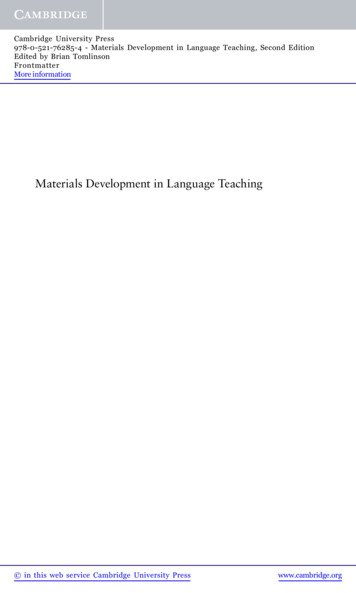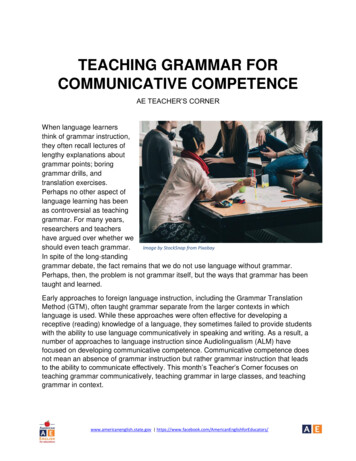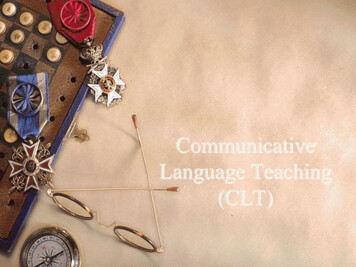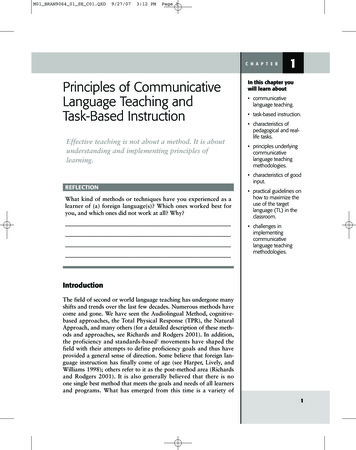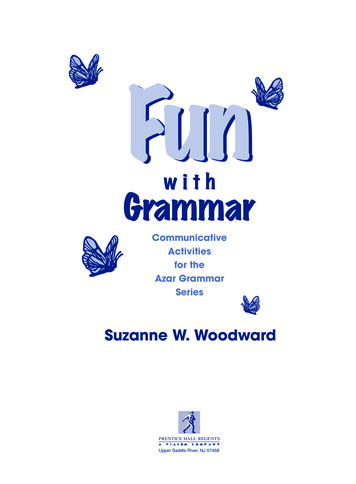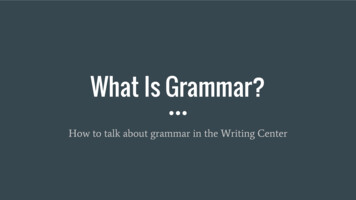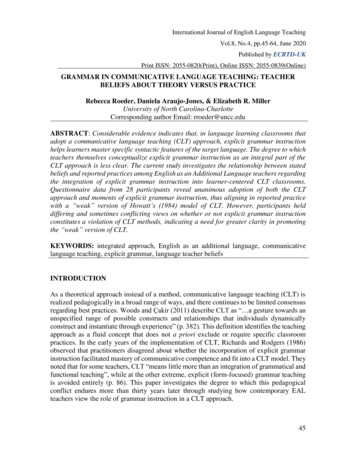
Transcription
International Journal of English Language TeachingVol.8, No.4, pp.45-64, June 2020Published by ECRTD-UKPrint ISSN: 2055-0820(Print), Online ISSN: 2055-0839(Online)GRAMMAR IN COMMUNICATIVE LANGUAGE TEACHING: TEACHERBELIEFS ABOUT THEORY VERSUS PRACTICERebecca Roeder, Daniela Araujo-Jones, & Elizabeth R. MillerUniversity of North Carolina-CharlotteCorresponding author Email: rroeder@uncc.eduABSTRACT: Considerable evidence indicates that, in language learning classrooms thatadopt a communicative language teaching (CLT) approach, explicit grammar instructionhelps learners master specific syntactic features of the target language. The degree to whichteachers themselves conceptualize explicit grammar instruction as an integral part of theCLT approach is less clear. The current study investigates the relationship between statedbeliefs and reported practices among English as an Additional Language teachers regardingthe integration of explicit grammar instruction into learner-centered CLT classrooms.Questionnaire data from 28 participants reveal unanimous adoption of both the CLTapproach and moments of explicit grammar instruction, thus aligning in reported practicewith a “weak” version of Howatt’s (1984) model of CLT. However, participants helddiffering and sometimes conflicting views on whether or not explicit grammar instructionconstitutes a violation of CLT methods, indicating a need for greater clarity in promotingthe “weak” version of CLT.KEYWORDS: integrated approach, English as an additional language, communicativelanguage teaching, explicit grammar, language teacher beliefsINTRODUCTIONAs a theoretical approach instead of a method, communicative language teaching (CLT) isrealized pedagogically in a broad range of ways, and there continues to be limited consensusregarding best practices. Woods and Çakir (2011) describe CLT as “ a gesture towards anunspecified range of possible constructs and relationships that individuals dynamicallyconstruct and instantiate through experience” (p. 382). This definition identifies the teachingapproach as a fluid concept that does not a priori exclude or require specific classroompractices. In the early years of the implementation of CLT, Richards and Rodgers (1986)observed that practitioners disagreed about whether the incorporation of explicit grammarinstruction facilitated mastery of communicative competence and fit into a CLT model. Theynoted that for some teachers, CLT “means little more than an integration of grammatical andfunctional teaching”, while at the other extreme, explicit (form-focused) grammar teachingis avoided entirely (p. 86). This paper investigates the degree to which this pedagogicalconflict endures more than thirty years later through studying how contemporary EALteachers view the role of grammar instruction in a CLT approach.45
International Journal of English Language TeachingVol.8, No.4, pp.45-64, June 2020Published by ECRTD-UKPrint ISSN: 2055-0820(Print), Online ISSN: 2055-0839(Online)Drawing on questionnaire data, the current study investigates the beliefs of 28 experiencedEAL teachers from a broad range of backgrounds and teaching experiences aboutincorporating explicit (form-focused) grammar instruction into classrooms that use acommunicative (meaning-focused) approach to English learning. All 28 teacher respondentsreport incorporating elements of explicit grammar teaching into their practice, whether theyview it as inherent to the CLT approach or not. Even so, their responses also point to apersistent ambiguity around how to define CLT, reflecting divergent beliefs about howgrammar should be taught in a CLT classroom. The paper concludes with severalobservations about the implications of this ongoing ambiguity for language teacherpractitioners.LITERATURE REVIEWGrammar in Communicative Language TeachingCLT as a strategy for teaching EAL began in the 1960s as a reaction to pedagogical methodssuch as Situational Language Teaching (which included pre-packaged conversationalexercises) and the Audiolingual method (which used memorization and drill-basedtechniques) (Richards & Rodgers, 1986). There has been an ongoing debate since theintroduction of CLT about “how to best support the development of grammatical accuracy”(Valeo & Spada, 2016, p. 314) when using this approach. While fluency is the primary goaland accuracy is secondary (Chung, 2005, p. 34), Savignon (1991) also observed that “for thedevelopment of communicative ability, research findings overwhelmingly support theintegration of form-focused exercises with meaning-focused experience. Grammar isimportant ” (p. 269). Such integration can be realized in various ways, however.Howatt (1984) described beliefs about teaching grammar in CLT in terms of “strong” and“weak” versions. According to the strong version, learners are expected to acquire grammarinductively; that is, as students learn, they develop an intuitive feeling for what is correct(Mammadova, 2016, p. 50). This interpretation of CLT was influenced by theComprehensible Input Hypothesis (Krashen, 1977) and the Interaction Hypothesis (Long,1996). As explained by Han (2002), in an extreme version of CLT such as this, “Formfocused instruction is deemed detrimental. Corrective feedback consequently is accordedlow status in classroom processes” (p.2). A considerable body of research has indicated,however, that this approach can result in EAL learners’ deficiency in the production ofgrammar patterns (i.e., in speaking and writing). For example, two studies that focused onMalaysia, Azerbaijan, and Taiwan observed that students who were trained solely underCLT methods developed fluency but lacked accuracy (Abdullah & Shah, 2015, p. 194;Subramanian & Khan, 2013, p. 43). In addition, there is a risk that fossilization may set inwithout direct correction, as noted by Subramanian & Khan (2013, p. 45). In such cases,grammatical accuracy may never be achieved. The study they carried out concluded that“CLT furnished with explicit instruction on form and meaning gives exposure to the learnersnot only to achieve fluency, but also accuracy in language use” (p. 43). The Noticing46
International Journal of English Language TeachingVol.8, No.4, pp.45-64, June 2020Published by ECRTD-UKPrint ISSN: 2055-0820(Print), Online ISSN: 2055-0839(Online)Hypothesis (Schmidt 1995) provides context for these results. This hypothesis states thatwhat learners notice in input is what becomes intake for learning (Schmidt, 1995, p. 9);therefore, noticing is crucial for language acquisition because if the input is not recognizedit is not internalized. “The noticing hypothesis,” as Schmidt (1995) explained, “claims thatlearning requires awareness at the time of learning” (p. 26). Schmidt’s hypothesis illustratesthat implicit grammar teaching may not be the most effective way to teach form to EALstudents, since they might not notice particular forms; consequently, they might not learnthem.In Howatt’s (1984) “weak” version of CLT, often conceptualized as a synthesis ofpedagogical approaches and commonly referred to as the Integrated Approach, a focus onmeaning and form work together to promote holistic learning. The theories ofcommunicative competence (Hymes, 1974) and functional linguistics (e.g., Halliday, 1970),as well as a belief in the efficacy of contextualized form-focused pedagogical practices,informed this interpretation of CLT. Functional linguistics, which emerged as a response toChomsky’s structural observations (e.g., 1957, 1975) and was developed as a complementto structural theory, highlights the symbiotic relationship between form and function inlanguage use. As the functional linguist Van Valin (2003) pointed out:[I]n functional linguistic analysis, forms are analyzed with respect to thecommunicative functions they serve and functions are investigated with respectto the formal devices that are used to accomplish them. Both form and functionin language are analyzed, not just function (p. 324).This fundamental concept of form and function as essential components of the languagesystem which cannot operate independently of one another underpins Howatt’s “weak”version of CLT. In discussing CLT as an emergent pedagogical approach rooted in thislinguistic theory, Canale and Swain (1980) wrote “ if a communicative approach to secondlanguage teaching is adopted, then principles of syllabus design must integrate aspects ofboth grammatical competence and sociolinguistic competence” (p. 6). According to thisinterpretation of CLT, some degree of explicit form-focused instruction is not antithetical toa CLT approach, especially since it serves to facilitate the stated primary goal for the learnerof achieving grammatical competence.There is also widespread support in subsequent literature for the incorporation ofcontextualized form-focused exercises into a meaning-focused CLT classroom (Abdullah &Shah, 2015; Celce-Murcia, 2001; Celce-Murcia & Larsen-Freeman, 1999; Chung, 2005; ElDakhs, 2014, 2015; Gutowska, 2017; Mammadova, 2016; Schmidt, 1995; Subramaniam &Khan, 2013; Terrell, 1991). For example, Liamkina and Ryshina-Pankova (2012) concludedthat a focus on categories of meaning can help learners achieve specific communicativepurposes. The experimental group in their study, who learned through explicit grammarlessons, including functional and situationally-based instruction, demonstrated increasedability to recognize and understand linguistic concepts that did not exist in their first47
International Journal of English Language TeachingVol.8, No.4, pp.45-64, June 2020Published by ECRTD-UKPrint ISSN: 2055-0820(Print), Online ISSN: 2055-0839(Online)language(s). They also performed better in speech production, in both immediate posttestsand delayed posttests administered two months later (p. 284).Overall, studies show that teaching form as a complement to the focus on meaning is moreeffective than instruction which focuses only on meaning or only on form (Lightbown &Spada, 1990; Spada 2011). For example, Mammadova (2016) reports on a study in whichEAL learners were separated into two groups—one instructed through implicit grammarmethods (focus on meaning) and the other instructed through explicit grammar methods(focus on form). As the research progressed, nearly 70% of the group taught through implicitgrammar methods started to fail in all activities, and she decided to add some elements ofexplicit grammar in order to help inform the students about the language forms that theywere exposed to, with the goal of increasing the rate of successful acquisition. Consequently,she ended up with a group of students learning through solely explicit grammar methods,and another group learning through a mix of explicit grammar and CLT methods. Posttestdata showed that the group with the mixed approach performed over 20% better than thegroup taught only through explicit grammar. In the same way, Subramanian & Khan (2013)studied two groups of EAL learners. The first group received semantic-based explicitgrammar instruction, and the second group did not receive any type of explicit grammarmethods of instruction. Subramanian and Khan (2013) concluded that form-focusedinstruction, using explicit grammar along with meaning-based activities, was beneficial forthe students to develop both fluency and accuracy in the second language. In summary,evidence abounds in support of the Integrated Approach, first formalized as Howatt’s (1984)“weak” version of CLT, according to which explicit grammar instruction is used in theclassroom as a complement to meaning-focused lessons. However, the persistent theoreticaldebate over best practices in CLT has resulted in a wide range of variation in teacher beliefs.Teacher BeliefsResearch indicates that language teacher beliefs greatly impact instructional decisions in theclassroom (e.g., Bell, 2005; Borg, 2003; Farrell & Lim, 2005; Richards, Gallo & Renandya,2001; Wong & Barrea-Marlys, 2012), so understanding these beliefs is essential toimproving teaching practices and educational programs (Farrell and Lim, 2005). Numerousstudies on CLT have examined teacher beliefs, focusing on correlations between teacherbeliefs and topics such as teaching experience (e.g., Sato & Oyanedel 2019), languagelearner beliefs (e.g., Valeo & Spada 2016), background or training (e.g., Sato andKleinsasser, 1999), and classroom practice (e.g., Basturkmen, Loewen & Ellis 2004;Basturkmen 2012).Several studies on the correlation between teacher beliefs and classroom practice found thatmore experienced teachers show a higher rate of convergence between stated beliefs andclassroom practices (e.g., Feryok, 2004; Mitchell, 2005). Regardless of experience, however,situational constraints such as prescribed curricula and institutional regulations can placerestrictions on teacher agency, preventing teachers who would like to implement explicitgrammar exercises in an EAL classroom from doing so (e.g., Farrell & Lim, 2005; Wong &48
International Journal of English Language TeachingVol.8, No.4, pp.45-64, June 2020Published by ECRTD-UKPrint ISSN: 2055-0820(Print), Online ISSN: 2055-0839(Online)Barrea-Marlys, 2012). Previous research has also found that teachers’ understanding ofpedagogical approach, including what CLT means, varies widely and largely reflects theirown second language learning experiences and training (e.g., Sato and Kleinsasser, 1999).Woods and Çakir (2011), based on discussions with six newly graduated second languageteachers in Turkey who supported CLT, found that these relatively inexperienced teachersbecame less rigid in their ideological rejection of explicit grammar exercises after observingsuch exercises being implemented by experienced teachers in a communicative way. Theauthors explain this finding as a mismatch between theoretical and practical knowledge. Thecurrent study contributes to this area of inquiry by further investigating the relationshipbetween stated beliefs and reported practices in regards to the role of grammar instruction inCLT.METHODOLOGYPurpose and ParticipantsThe purpose of this study is to learn about EAL teachers’ beliefs about the need for explicitgrammar instruction within a CLT framework and their reported inclusion of explicitgrammar teaching in their classrooms in order to examine how contemporary teachersunderstand and implement the CLT approach. In particular, the following research questionsguided the study:1. What are EAL teachers’ beliefs about incorporating direct grammar instruction intoa CLT classroom?2. Do EAL teachers report incorporating direct grammar instruction into the classroom,as a complement to CLT methodologies?3. Do teachers’ reported practices and stated beliefs correspond?Our findings come from questionnaire data collected from 28 EAL teachers (4 men, 24women), ranging in age from late 20s to 60s. The second author recruited participants viaface-to-face discussion and word-of-mouth, as well as by email, resulting in 17 non-localparticipants and 11 local participants. At the time of their participation in the current study,the 11 local participants were the second author’s co-workers at an English languageteaching institute affiliated with a university in the southeastern United States, and four ofthe non-local participants had previously worked at the same English language teachinginstitute. All but two participants were still teaching. Appendix A provides additionaldemographic information for each participant. In sum, most participants are women whospeak English as a first language, hold a master’s degree, and have taught EAL for morethan 10 years. Participant teaching experience includes over 12 countries across Europe,Central and South America, and Asia, comprising an extensive list of first languages amonglearners. University-based English language programs are the most common setting, but49
International Journal of English Language TeachingVol.8, No.4, pp.45-64, June 2020Published by ECRTD-UKPrint ISSN: 2055-0820(Print), Online ISSN: 2055-0839(Online)teaching venues also include prisons, refugee programs, non-profit community ESL, adulteducation as well as other government-sponsored programs. As such, the study participants(individually referred to hereafter by number—from participant #1 (P1) to participant #28(P28)) represent a broad range of EAL teaching experiences and backgrounds.MaterialsData was elicited via a questionnaire (Appendix B) that was created by the second authorbased on anecdotal observations as an EAL teacher as well as discussion with fellow EALteachers. As such, the questions adopt the type of language used by teachers themselves indiscussing EAL teaching approaches. It consists of three parts, as follows: 1) demographicquestions; 2) open-ended questions about pedagogical practice (Q1-Q4); and 3) a series of15 Likert scale statements (S1-S15), also pertaining to teaching practices, preferences, andmethodology. Data elicitation involved the second author meeting face-to-face with the 11local participants to discuss the questionnaire in an interview-type setting and the 17 nonlocal participants returning their completed questionnaires via email. The second author,who has over 20 years of EAL teaching experience herself, having taught English in bothher home country of Brazil and in the United States, followed up through email with 11 ofthe remote participants to clarify answers. We focus here on the responses to a subset ofthese questions—namely Q1-Q4, S1 and S8—that illustrate the inconsistent and sometimesparadoxical views that emerged regarding the use of form-focused instruction within a CLTcontext. We also discuss items S11-S15, which asked teachers to identify the most importantgrammatical features to teach students.RESULTS AND DISCUSSIONThe following sections discuss results from the second and third parts of the questionnaire,which focused on teacher beliefs and their self-reported pedagogical practice.Experience as a contributing factor to perspectiveIn response to the first part of Q1 (“Did you teach ESL prior to the CommunicativeApproach?”), 14 respondents replied that they had used methods outside of CLT in theirteaching practice and 14 replied that they had not. Interestingly, previous use of non-CLTmethods did not correlate with a consistent pattern of responses to Q2 (“In your opinion, isthe Communicative Approach effective in grammar teaching?”), apart from the expectedfinding that teachers with experience in more than one methodology often had a morenuanced understanding of the benefits of CLT in contrast to other methods. With respect tointerpretations of what it means to teach within a CLT approach, results showed considerablein-group variation. Some respondents in both groups indicated that CLT is not effectivewithout an explicit grammar component, revealing an interpretation of CLT that does notinherently include explicit grammar instruction. Alternatively, some respondents indicatedthat CLT is effective in facilitating grammar learning due to the affordance of targeted50
International Journal of English Language TeachingVol.8, No.4, pp.45-64, June 2020Published by ECRTD-UKPrint ISSN: 2055-0820(Print), Online ISSN: 2055-0839(Online)grammar lessons within the context of real language use, revealing an interpretation of CLTthat does include use of direct grammar instruction where appropriate. The lack ofcorrelation between non-CLT teaching experience and beliefs about what a CLT approachentails indicates that one’s understanding of CLT is shaped by factors other than experiencewith other teaching methods, at least for these participants. The finding may also be partlyexplained by the fact that all participants had a minimum of seven years of experience asEAL teachers and had therefore had time to develop a sophisticated understanding of whatworks in the classroom. We examine specific approaches to grammar instruction in the nextsection.Value of direct grammar instructionIn responding to Q4 (“Do you catch yourself using traditional grammar teaching methods inyour classroom from time to time? If yes, why do you think that happens?”), 26 of the 28participants (93%) answered “yes”, reporting that they reinforce the implicit grammarapproach by using additional explicit strategies to teach grammar. The most commonexplanations were as follows: the belief that students need explicit explanations, the need torespond to a student request, and their observations that such practice has proven to beeffective. In agreement with findings from previous research (e.g., Farrell & Lim, 2005;Wong & Barrea-Marlys 2012), however, institutional expectations were cited by a few as aconstraint on teacher agency in regards to practicing direct grammar instruction. Forexample, when teacher P5 was teaching in an institution that required instructors to usesolely CLT approaches, she remembered closing the door in order to discuss grammar withstudents directly. This example indicates a belief on the part of the teacher that explicitdiscussion of grammar with students did not qualify as a CLT approach, or at least not at herinstitution.Two teachers, P8 and P19 answered “no” to Q4, initially reporting that they do not rely onexplicit grammar teaching. Consistent with this response, both also stated their belief thatCLT is effective in teaching grammar (Q2). Taken together, these responses reflect a beliefin Howatt’s “strong” version of CLT, implying that the implicit grammar process issufficient in order for adult additional language learners to master grammar. On furtherdiscussion, however, both respondents acknowledged including targeted grammarinstruction in their lessons. Teacher P19 reported that he does bring grammar structures tothe attention of his students, in the interest of effective communication. At the same time, hereported that “we use language to do something” in his classes, thereby aligning himself witha “weak” CLT perspective, reflecting ideas relating to communicative competence (Hymes,1974) and functional linguistics (Halliday, 1970) frameworks. When asked to give anexample, teacher P19 stated that after defining the communicative situation and the task, hegives students steps to accomplish the task. To do so, he “isolates the grammatical featuresto work with, not overwhelming students with too many”, and then relates these specificfeatures to the task they are trying to accomplish. In the same way, after being requested viaemail to give an example of drawing attention to form, teacher P8 replied as follows:51
International Journal of English Language TeachingVol.8, No.4, pp.45-64, June 2020Published by ECRTD-UKPrint ISSN: 2055-0820(Print), Online ISSN: 2055-0839(Online)So, what I mean by ‘direct instruction’ is that, yes, students do need explicit(direct) instruction of grammar point(s), but those points are drawn from theirown writing productions. Once I identify the point(s) from a particularwriting, the writing itself is the ‘pre-assessment’ for the grammar structureand then becomes a graded item in a post assessment.She went on to provide the following additional example, from a recent class with ChineseEAL learners: [I] noticed they were having difficulty with dangling modifiers. Forexample: Installing superconductive materials, AI (artificial intelligence) hasadvanced significantly [italics in original]. So, the problem here is that AIcannot “install superconductive materials.” I noticed this kind of error inmultiple students’ writings, so it became a good direct instruction point ashow to avoid this kind of error.Valeo and Spada (2016), describe two types of form-focused activities, isolated andintegrated. Isolated form-focused instruction occurs when “learners’ attention is drawn toform separately from communicative activities, that is, before, in preparation, or after acommunicative activity” (p. 314). According to this definition, Teacher P8’s explanationand example illustrate isolated form-focused instruction. Nonetheless, she also relies onmaterial that emerges from the learners themselves to teach grammatical elements oflanguage, reflecting a learner-centered model that this teacher may conceptualize ascontrasting with “explicit” grammar teaching. In this way, both P8 and P19 demonstrate thatwhile their reported beliefs support a “strong” version of CLT which involves avoidingtraditional grammar instruction, their actual practice incorporates contextualized andsituationally determined grammar instruction.Table 1 shows responses to the Likert scale question S1 (“I do not show my students explicitgrammar structures.”). Similar to findings from Q4 (“Do you catch yourself using traditionalgrammar teaching methods in your classroom from time to time? If yes, why do you thinkthat happens?”), the majority of participants self-report using explicit grammar methods,with 23 participants (82%) either disagreeing or strongly disagreeing.52
International Journal of English Language TeachingVol.8, No.4, pp.45-64, June 2020Published by ECRTD-UKPrint ISSN: 2055-0820(Print), Online ISSN: 2055-0839(Online)Table 1. Participant response to S1 “I do not show my students explicit grammarstructures.” (N 28)Scale# ofteachers%strongly ly agree14%In providing further explanation for her response to this question, P11, a teacher who hasbeen teaching for 30 years at university-based English language institutes, stated that goodlanguage learners will pick up some grammar while mediocre and poor learners do not. Shethen added that even when a good student picks it up, they may doubt themselves, providingadditional evidence that instructors are often the main source of accurate language contentand that providing direct grammar instruction can aid students’ language learning. In otherwords, explicit grammar instruction can facilitate learning not only when a form goesunnoticed by a student during learner-centered communicative exercises but also when aform that has previously been noticed by the student, in a way that is compatible withSchmidt’s (1995) Noticing Hypothesis, is subsequently confirmed in the classroom througha form-focused exercise.Another notable finding displayed in Table 1 is that three respondents agreed or stronglyagreed with S1 (“I do not show my students explicit grammar structures”) and two wereneutral. Interestingly, there is no overlap between these five respondents and the two whosaid ‘no’ to Q4 (“Do you catch yourself using traditional grammar teaching methods in yourclassroom from time to time?”). One of the two teachers who said ‘no’ to Q4 disagrees withS1 and the other teacher strongly disagrees. This seeming contradiction indicates that thesetwo teachers have different definitions of “traditional grammar teaching methods” and“explicit grammar structures”. One of these two respondents, teacher P8, commented asfollows:I have always understood traditional grammar teaching as relying ongrammar texts to lead the way in what is being taught and in a certainsequence. It would involve showing form, doing exercises, then applying theform in some authentic way. When I was inexperienced as a teacher, thetraditional approach felt safe to me because it seemed that publishers put alot of brainpower into their texts and I should trust that. By explicit instruction53
International Journal of English Language TeachingVol.8, No.4, pp.45-64, June 2020Published by ECRTD-UKPrint ISSN: 2055-0820(Print), Online ISSN: 2055-0839(Online)[italics in original], I understand it as direct instruction of some point, but alsostructured and contextualized drawn from their own writing productions.Participant responses to Likert scale question S8 (“If I never show my students grammar,they still learn it because they read and hear it spoken”), presented in Table 2, are somewhatmore ambiguous than results for Q4 or S1.Table 2. Participant responses to S8: “If I never show my students grammar, they stilllearn it because they read and hear it spoken” (N 28)Scale# ongly agree27%strongly disagree%Table 2 shows that 16 of the 28 respondents (57%) disagree or strongly disagree that studentswill learn grammar without being explicitly taught by the EAL teacher. It is important tonote here, however, that even those seven respondents who supported the statement didindicate elsewhere in the questionnaire that direct grammar instruction in the classroom isnecessary at times. These inconsistent responses suggest ambiguity in the minds of at leastsome of the participants regarding their beliefs about using explicit grammar instruction.Finally, in further accord with the general agreement that drawing student awareness tospecific grammar structures is an essential part of the learning process, participants providedsimilar motivations for why they use traditional grammar teaching methods in theirresponses to the second part of Q4 (“Do you catch yourself using traditional grammarteaching methods in your classroom from time to time? If yes, why do you think thathappens?”). Results are presented in Table 3.54
International Journal of English Language TeachingVol.8, No.4, pp.45-64, June 2020Published by ECRTD-UKPrint ISSN: 2055-0820(Print), Online ISSN: 2055-0839(Online)Table 3. Participant explanation for using traditional grammar teaching methods (N 28)# ofteachers%best practice, in general1761%when students ask/are not otherwise catching on518%best practice for lower levels27%I learned that way27%no explanation27%ExplanationThe most common response by far is the belief that including some direct grammarinstruction is a best practice. A representative explanation for why explicit grammarinstruction is so broadly used comes from teacher P6, who remarked that “students mayrepeat the same structural mistakes, the error persists, therefore it needs to be shown to themexplicitly.” Similarly, teacher P28 stat
functional teaching”, while at the other extreme, explicit (form-focused) grammar teaching is avoided entirely (p. 86). This paper investigates the degree to which this pedagogical conflict endures more than thirty years later through studying how contemporary EAL teachers view the role o
